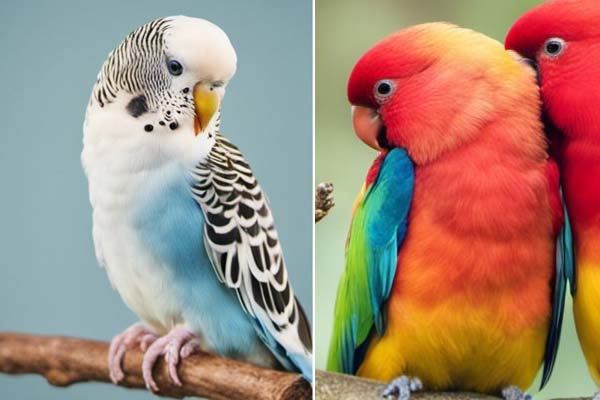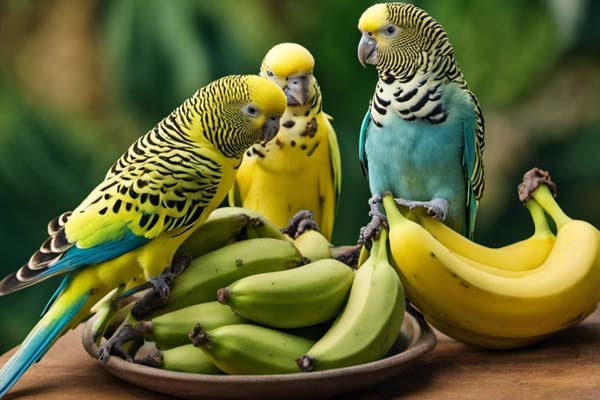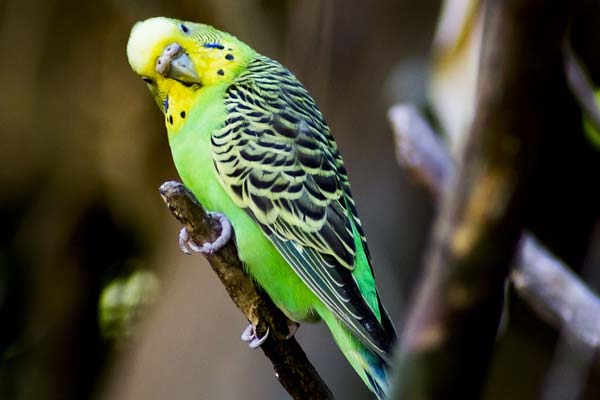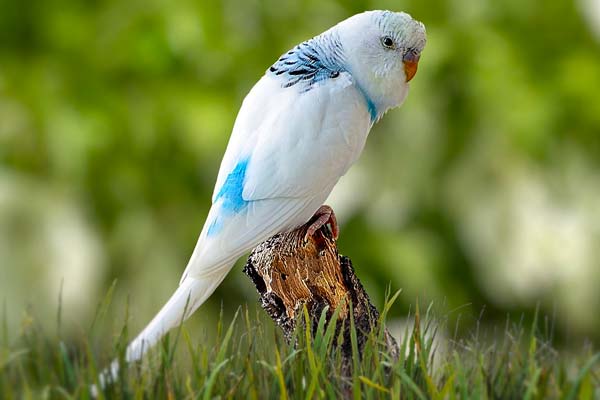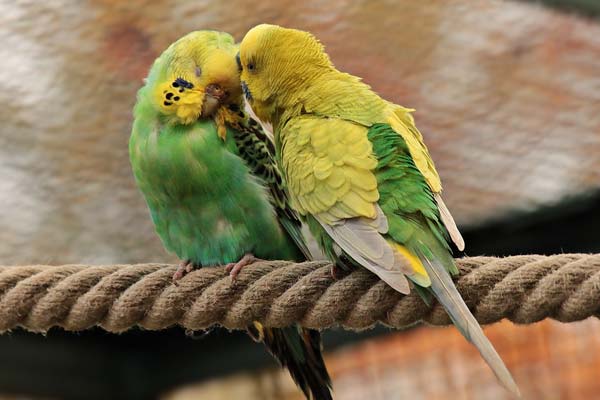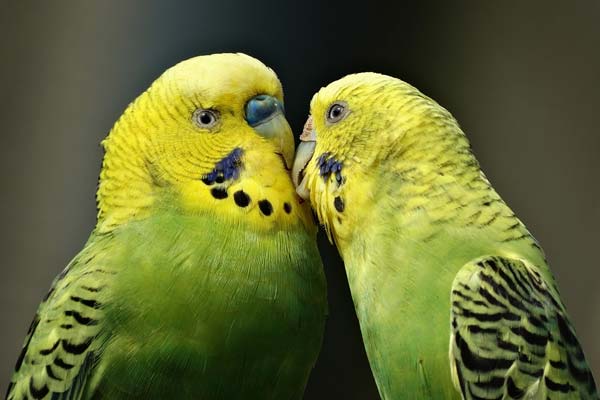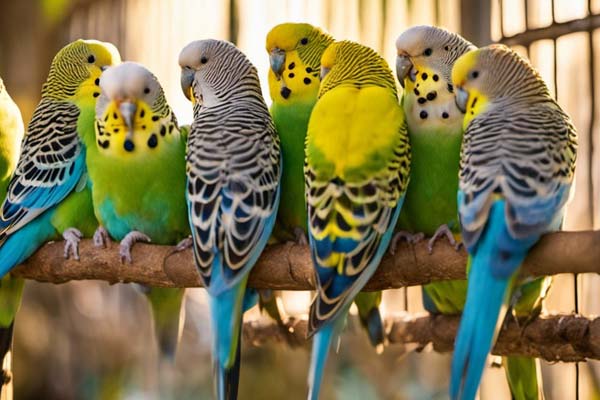Parakeets vs. Lovebirds: Which Makes the Better Pet?
Parakeets and lovebirds are two of the most popular pet birds in the world. Both species are known for their vibrant colors and playful personalities, but their distinct differences make them unique.
Selecting the ideal pet bird requires a thorough grasp of the distinctions and similarities between parakeets and lovebirds, making your final decision easier.
One of the most significant differences between parakeets and lovebirds is their size. Parakeets are generally larger and more slender, while lovebirds are shorter and stout. Lovebirds also have blunter and shorter tail feathers than parakeets.
Also, lovebirds are more friendly and are known for making more noise than parakeets. On the other hand, parakeets are more independent and tend to be quieter.
Parakeets and lovebirds can make excellent pets for the right owner despite their differences. It’s essential to consider noise level, temperament, and care requirements before deciding.
Physical Characteristics and Appearance
Parakeets and lovebirds are both small and colorful birds that are popular choices as pets. However, some physical differences between the two species can help distinguish them.
Species Varieties
Both parakeets and lovebirds have various species and subspecies, each with unique physical characteristics and appearance. For instance, parakeets have over 120 species, while lovebirds have nine.
Some of the most popular parakeet species include the budgerigar, the Alexandrine parakeet, and the Indian ring-necked parakeet. Lovebird species have the peach-faced lovebird, the masked lovebird, and the Fischer’s lovebird.
Size
In terms of size, parakeets are generally longer than lovebirds, but lovebirds are heavier and have larger beaks. Lovebirds typically grow about 5 to 6.5 inches, while parakeets can grow up to 18 inches. Additionally, lovebirds have shorter tail feathers, giving them a blunted appearance, while parakeets have longer pointed tails.
Color
Both parakeets and lovebirds come in various colors, with some species having more color variations than others. Parakeets can be found in colors ranging from green to blue to yellow and even white. On the other hand, lovebirds come in various colors, including green, blue, orange, and white.
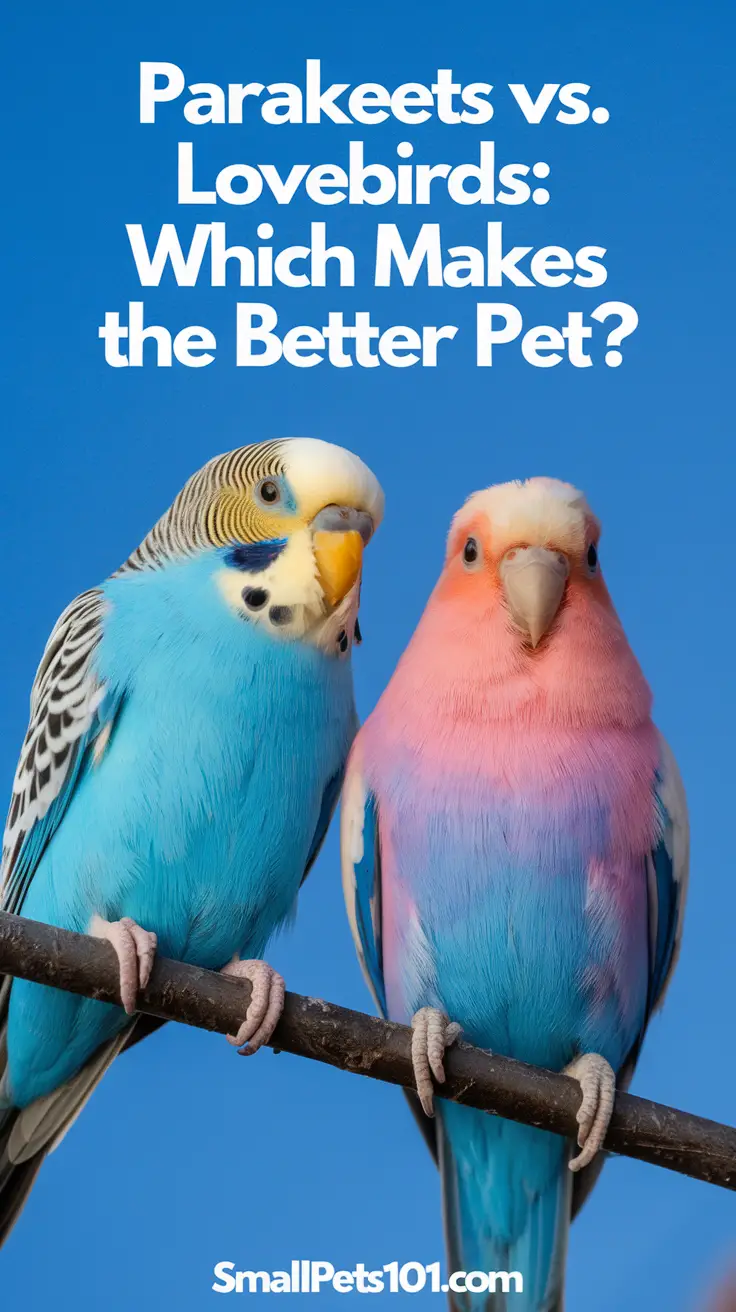
Temperament and Personality
Regarding temperament and personality, parakeets and lovebirds have some notable differences.
Social Behavior and Interaction with Humans and Pets
Parakeets are known to be more social and outgoing than lovebirds. They tend to enjoy the company of their owners and other birds and are more likely to engage in playful behavior.
Lovebirds, conversely, are more territorial and can become jealous if they feel their owner’s attention is being diverted elsewhere. They may be more prone to biting if they feel threatened or uncomfortable.
Both parakeets and lovebirds can form strong bonds with their owners, but lovebirds tend to be more affectionate and cuddly. They enjoy being held and petted, while parakeets may be more inclined to fly around and explore their surroundings.
Intelligence, Trainability, and Friendliness
Both parakeets and lovebirds are trainable and intelligent birds. Parakeets tend to be easier to train because of their friendly nature, whereas lovebirds might demand more patience and persistence.
Regarding their friendliness, both species can make beautiful pets with dedication. Parakeets tend to adapt well to different environments and people, while lovebirds may be more selective in their interactions, preferring to trust a chosen few.
Housing and Care Requirements
Parakeets and lovebirds share similar housing and care requirements, with the following key points to keep in mind:
Ideal Cage Size, Design, and Placement
Parakeets and lovebirds require a spacious cage, ideally measuring at least 18 inches in width, 18 inches in depth, and 24 inches in height for a single bird. If you plan to house multiple birds, opt for a larger cage, aiming for 2 to 3 square feet of space per bird.
Ensure the cage is constructed from durable materials like stainless steel or powder-coated metal, avoiding sharp edges or potential bird-trapping gaps. It’s crucial to have a secure door and locking mechanism to prevent any unintended escapes.
Select a well-lit location for the cage, but shield it from direct sunlight, drafts, and extreme temperatures. Avoid placing the cage in noisy or high-traffic areas of your home to minimize stress for the birds.
Perches, Toys, and Enrichment
Parakeets and lovebirds require diverse perches and toys for mental and physical stimulation. To cater to their needs effectively, offer perches in various sizes and textures, including natural wood, rope, and plastic, to promote foot health.
Regarding toys, prioritize those crafted from safe, non-toxic materials and rotate them regularly to prevent boredom. Consider options like bells, swings, mirrors, and puzzle feeders.
Additionally, they incorporate enrichment activities into their daily routine to keep them engaged and content. Foraging toys, filled with treats or food, can be a great choice.
Furthermore, engage in training sessions to teach them tricks or commands, adding another layer of mental stimulation and interaction.
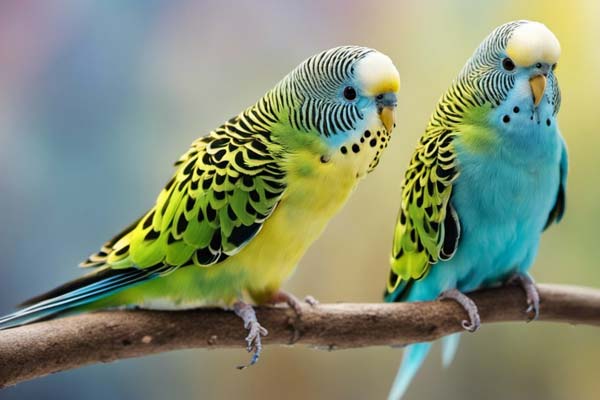
Hygiene and Cleaning Tips
Maintaining a clean cage is vital for the well-being of your birds. Clean the cage weekly or more frequently, removing uneaten food, droppings, and debris. Use a mild disinfectant to wipe it down.
Ensure the birds’ food and water dishes are cleaned and replenished daily with fresh supplies. Offer a separate dish for bathing, as many birds love water play.
Remember regular veterinary check-ups to keep your birds in good health. Watch for signs like lethargy, appetite loss, or behavior changes, and consult a vet if needed.
Vocalization and Noise Levels
When it comes to vocalization and noise levels, both parakeets and lovebirds are known to be quite chatty. However, there are some differences between the two birds in terms of their typical sounds and calls.
Typical Sounds and Calls
Parakeets are renowned for their capacity to imitate human speech and acquire an extensive vocabulary of words and phrases, in addition to their repertoire of vocalizations, which includes whistles, chirps, and squawks. In contrast, while lacking proficiency in mimicking speech, lovebirds possess a unique high-pitched screeching call.
Comparing the Volume of Vocalization
Regarding volume, both parakeets and lovebirds can be pretty loud, incredibly excited, or scared. However, there are some differences in their typical noise levels.
Parrotlets are the quietest parrots, creating an average of 65 decibels of noise. Budgies can reach 68 decibels. On the other hand, lovebirds have a volume reaching around the 83-decibel range.
It is important to note that the noise level of a bird can vary depending on its personality and environment. Some parakeets may be quieter than others, while some lovebirds may be louder. Also, proper training and socialization can help reduce excessive noise levels in both birds.
Diet and Nutrition
Regarding the diet of parakeets and lovebirds, both species require a balanced diet that includes seeds, fruits, vegetables, and pellets. However, there are some differences in their dietary preferences.
Dietary Preferences: Seeds vs. Pellets
Parakeets are known to be seed-eaters, and they enjoy a variety of seeds, such as millet, sunflower seeds, and safflower seeds. On the other hand, lovebirds tend to prefer pellets over seeds. Pellets are a complete and balanced diet providing all the nutrients for lovebirds. However, it is essential to note that lovebirds may require a higher fat content in their diet due to their more active metabolism.
Importance of Fresh Fruits and Vegetables
Parakeets and lovebirds require fresh fruits and vegetables to stay healthy, as these foods supply vital vitamins and minerals. Suitable options for their diet include apples, oranges, carrots, broccoli, and spinach.
Health Considerations Related to Nutrition
Providing a well-balanced diet to parakeets and lovebirds is essential to prevent nutritional deficiencies. A lack of proper nutrition can cause feather loss, irritation, and infection when feathers are plucked. It is also important to avoid feeding them foods toxic to birds, such as avocado, chocolate, and caffeine.
Lifespan and Health Considerations
When choosing between a parakeet and a lovebird, it’s essential to consider their lifespan and health needs. Here are some key factors to keep in mind:
Average Lifespan and Common Health Issues
On average, lovebirds live for around 10-15 years, while parakeets also have a lifespan of 10-15 years. However, with proper care and attention, both species can live longer. For instance, some parakeets have been known to live up to 20 years.
Both lovebirds and parakeets are prone to specific health issues. For example, respiratory infections are common in both species, especially if kept in damp or dirty environments.
Lovebirds are also susceptible to psittacosis, a bacterial infection that can be transmitted to humans. On the other hand, parakeets are prone to feather plucking, which can be caused by stress, boredom, or illness.
To maintain your bird’s well-being, offering a clean, secure habitat, a well-rounded diet, and consistent physical activity is crucial. If you observe any illness indications, like lethargy, reduced appetite, or altered behavior, promptly seek veterinary care.
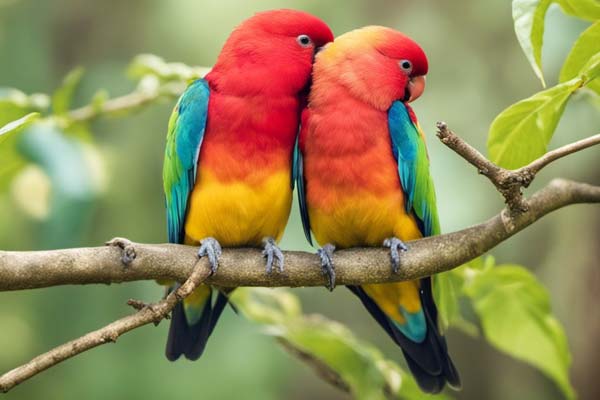
Regular Health Check-ups and Allergies
Routine health check-ups are vital for the well-being of both lovebirds and parakeets. During these examinations, a veterinarian will assess your bird’s health, detect potential illnesses, and suggest appropriate treatments or preventive actions.
It’s worth mentioning that individuals within your household might have allergies to bird feathers or dander. Before adopting a bird, it’s crucial to consider this possibility. To minimize the risk of allergies, maintain a clean and well-ventilated cage for your bird and reduce direct contact with their feathers or dander.
Compatibility and Breeding
Regarding compatibility and breeding, it is essential to note that lovebirds and parakeets are not genetically compatible. While they could theoretically mate, the chances of producing offspring are slim due to their different temperaments. Lovebirds are known to be more aggressive towards other species, including parakeets.
As for living together, lovebirds and parakeets can coexist in the same aviary. However, it is crucial to monitor their interactions closely as lovebirds can be territorial and may become aggressive towards their parakeet companions. Providing ample space and separate feeding areas is recommended to minimize potential conflicts.
It is also important to note that lovebirds and parakeets have different breeding habits. Lovebirds are known to be more territorial and may become aggressive towards other birds during breeding season. In contrast, parakeets are more social and breed more easily in pairs or groups.
| Lovebirds | Parakeets |
|---|---|
| More aggressive towards other species | More social and tend to breed more easily in pairs or groups |
| Territorial during the breeding season | Less territorial during the breeding season |
| May become aggressive towards parakeet companions | May coexist with lovebirds in the same aviary with proper monitoring |
| Different breeding habits | Different breeding habits |
Maintenance and Care Requirements
Taking care of a pet bird requires a significant amount of time and effort. Both parakeets and lovebirds have specific maintenance and care requirements that owners must follow to ensure their health and happiness.
Exercise, Enrichment, and Grooming Needs
Parakeets and lovebirds are active birds that require daily exercise and enrichment. Providing them with toys, perches, and swings inside their cage can help keep them entertained and active. Owners should also let their birds out of their cages for at least an hour daily to fly and stretch their wings.
Bird grooming is a crucial aspect of caring for parakeets and lovebirds. Regular nail trimming and wing clipping are necessary to prevent injuries and ensure safety. It’s also essential to provide them with baths or mist their feathers to maintain cleanliness and feather health.
Cleaning and Hygiene Tips
Keeping a clean living environment is crucial for a bird’s health. Owners should clean their bird’s cage at least once weekly, replacing the bedding, food, and water dishes. Additionally, they should clean the cage bars, toys, and perches with a bird-safe disinfectant to prevent the spread of bacteria and diseases.
Owners should monitor their bird’s droppings for signs of health. Healthy droppings are firm, with a combination of green and white. Any alterations in color, texture, or frequency should prompt owners to seek prompt veterinary care as they may signal underlying health concerns.
Cost of Ownership
When considering pet birds, factoring in the associated costs is essential. Parakeets and lovebirds come with similar price tags, but there are some distinctions to remember.
Initial Setup Expenses
The initial setup for a parakeet or lovebird can be expensive. Here are some things to consider:
- Cage: A good-sized cage is essential for your bird’s well-being. A cage for a parakeet can cost anywhere from $30 to $100, while a cage for a lovebird can cost anywhere from $60 to $200.
- Perches: Your bird will need perches of different sizes and materials to keep its feet healthy. Perches can cost anywhere from $5 to $20 each.
- Food and Water Dishes: Ensure your bird has food and water dishes, which typically range in price from $5 to $15 each.
- Toys: Birds require toys for entertainment and mental stimulation, with prices typically ranging from $5 to $20 per toy.
- Other Supplies: You may also need to purchase different supplies, such as bird baths and cleaning supplies. These can add up quickly.
Ongoing Costs and Budgeting for Veterinary Care
Once you have set up your bird’s home, ongoing costs must be considered. Here are some things to keep in mind:
- Food: Birds need a balanced diet with seeds, pellets, fruits, and vegetables. The cost of food will depend on the type and quality of food you choose.
- Veterinary Care: Birds require routine check-ups and may necessitate veterinary attention for their health. The expense of veterinary care fluctuates based on your location and the specific care needed.
- Other costs include bedding, cleaning supplies, and replacement toys.
Frequently Asked Questions (FAQs)
Friendliness Comparison: Lovebirds vs. Parakeets
Lovebirds and parakeets are both social birds and can make good pets. However, lovebirds tend to be more aggressive and territorial than parakeets. Lovebirds can be pretty possessive of their owners and may become aggressive towards other pets or people. On the other hand, parakeets are generally more friendly and sociable towards other birds and humans.
Mating and Living Together: Parakeets and Lovebirds
Both lovebirds and parakeets are social birds and can form strong bonds with their mates. However, it is essential to note that lovebirds are monogamous and can become aggressive towards other birds if they feel threatened.
On the other hand, parakeets are more adaptable and can live in flocks or pairs. Lovebirds and parakeets can live together, but it is vital to introduce them gradually and monitor their behavior to ensure they get along.
Beginner-Friendly: Parakeet vs. Lovebird
Parakeets are often favored by beginners due to their ease of care and manageable size, making them simpler to handle and accommodate. In contrast, lovebirds pose a greater care challenge, demanding more owner interaction and attention.
Parakeet and Lovebird Behavior: Differences and Similarities
Both lovebirds and parakeets are active and playful birds that enjoy interacting with their owners. However, there are some critical differences in their behavior. Lovebirds are more vocal and tend to make more noise than parakeets.
Lovebirds are also more active and require more space to move around. Parakeets are generally quieter and more docile, making them better suited for apartment living.
Do Parakeets and Lovebirds Bite?
Both lovebirds and parakeets have the potential to bite, especially if they feel threatened or are not properly socialized. However, parakeets are generally less likely to bite than lovebirds. Handling both birds gently and consistently is vital to prevent biting behavior.

